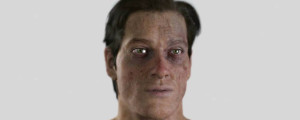Ed Atkins’ ‘Hisser’ is inspired by the true story of a man in Florida whose bedroom fell into a sinkhole that opened suddenly and was never found. The immersive dimension of the exhibition consists two-channel video with multiple audio channels and mixed media. It presents at Brussel’s dépendance, running October 31 to November 28, and almost constitutes a closed box. Entering the space from the back of the set, the viewer finds themselves facing the double video display, giving it the sense of looking at oneself in the mirror. Before walking in the installation, a quotation by famous American writer and activist Helen Keller -printed on a poster representing a wolf’s head -warns us, “Avoiding danger is no safer in the long run than outright exposure… Life is either a daring adventure or nothing”.
It is the same poster which is pinned above the bed of the character in the ‘Hisser’ video whose bed (and life) is on the brink of collapse into a sinkhole. Inside, the high definition video plays concurrently on two large projections and shows the inside of a man’s bedroom, which in turn tries to show us the inside of him. The scene takes place at night, windows are opened, curtains are shaken by the wind. The bed is sometimes empty, sometimes occupied by the man in the grip of the sadness, anxiety. Talking to himself, inhaling, panting; sometimes he tries to fall asleep, to calm his spirit. “I’m sorry, I didn’t know”, the digitised voiceover says.

Stretched out with eyes open in his white sheets, sat in front of his bedroom door, or going through forms sketched in ink on pieces of paper like a kind of Rorschach test, we are the whole inside his body, merged with his corporeality, devoured by it. The fuzziness of the image picked up by a subjective camera could be his view blurred by tears. An oppressive sound heard as if underwater could also be his breath. Another sound, of a hard drive or software repeats throughout in the film. We could ourselves become his random access memory.
Realised in CGI and animation, ‘Hisser’ questions the successive breaks at work in the equation of representation and technology. Between full technological power and human failure, ‘Hisser’ shows a character at the heart of a universe of mold-able movie effects, where in their emancipation they are also paradoxically prisoner of themselves; of a human condition, a psychic wandering. If physically this wandering is not limited to the space of the huge white desert landscape where the character finds himself walking naked at the end of the film, it indeed finds its breaking points in the story: when the rooms collapses, when the man kind of cries looking at the viewer from his bed. The video and audio also breaks in the image editing and sound treatment; effects which tremble or split into halves and a sound that is suffocating. It’s a reality which twists itself, which repeats itself, as a mirror of itself as well.

Atkins uses modern tools and forms to produce a film which plays on a tipping point between the ultra-presence of the image and a total wandering; a perdition, a quasi-disappearance of a character in the grip of doubt, fear, loneliness and death. But in spite of this ampleness of device, it makes the process of compassion just as extreme, a kind of existential vacuity persists. Because it is indeed the failure which is at work here. It’s something that is controlled by the digital tool, but how is it embodied in the image? How does the feeling of the protagonist reach us? How can all our psychic suffering -which make us human – be at work in this hyper-realistic representation of this man?
In an2014 interview with Modern Painters Magazine the artist was asked the question of how he came to the hyperreal HD aesthetic for his videos, to which he responded: “It offers some weird possibility for performing the endeavour toward verisimilitude — lifelikeness — while completely falling short or, rather, falling back into image and structure and manipulation and design. It’s this axis of emotion and artifice and performance and power that I’m totally into”. ‘Hisser’ speaks to this ‘verisimilitude’, in a concept of digital i-representativeness, the paradox of the hyper-reality that is somewhere between super-materiality and invisible substance. **
















